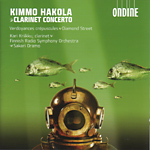Kimmo Hakola’s Clarinet Concerto begins in a brassy freight train rhythms that remind of the music from the Matrix films. The clarinet leaps out of this frenzy into a series of acrobatic maneuvers that exploit the full capabilities of the instrument. This is quite impressive, though the cadenza, with its playfully silly writing (reminding of those “cute animal” scenes in old movies) is less so. Kari Kriikku executes all this with enthusiasm, daring and stunning musicianship. Kriikku doesn’t shy away from the ocassional “ugly” sounds the composer asks for, such as the raspy honking than constitute the sour in the otherwise sweetly creamy adagio. The rhythmically exciting 7/8 third movement initially sounds like jazz, but Hakola actually based it on an oriental dance which ends abruptly with the raucous crowd noises that announce the start of the Kahsene (wedding) finale. Kriikku makes a most convincing Klezmer player, sounding mournful in the slow sections, then whipping up the celebration in the fast and rowdy conclusion. But the problem is that it sounds like the finale to another work entirely, as its so stylistically different from the quasi-modernist first movement. Still, the Finnish Radio Symphony performs with remarkable panache and precision under Sakari Oramo’s vital direction.
Verdoyances crépuscules (verdant twilight) really sounds like its title, as it moves through a succession of sustained chords, abetted by organ and flowing harps, giving the feeling of a voyage into outer space (think Holst’s Neptune meets John Williams’ Close Encounters of the Third Kind). After this Kriikku is back for a solo turn in Hakola’s Diamond Street. The piece recalls the klezmer-style writing of the Concerto, and Kriikku once again proves a talented and spirited performer. Ondine’s recording is a touch bright, but powerfully conveys the dynamic impact of the music.
































